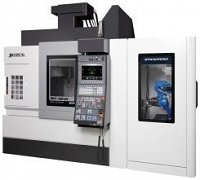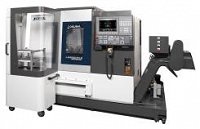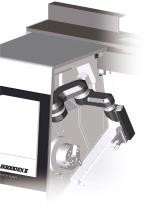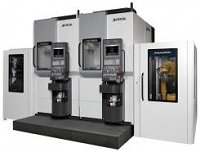Okuma presents robotics of the future
25.09.2019
Okuma offers state-of-the-art automation solutions for all types of needs. At this year’s EMO Hannover (16-21 September 2019), the Japanese manufacturer presents ARMROID and STANDROID, two innovative solutions for advanced automatisation that are simple to install, easy to operate, productive and space-saving. With their introduction, Okuma sets standards for automation in the metalworking industry.
ARMROID revolutionises the machining process
 ARMROID is the world’s first robotic arm integrated into a CNC machine tool. It can be used for automatic loading and unloading as well as for support during the manufacturing process, opening entirely new possibilities in terms of automation and cutting. The robot is located in the machining chamber of an Okuma LB 3000 EX II lathe. The special position enables the robot arm to operate during the manufacturing process. With three different end effectors, the solution is able to perform different tasks. It improves chip management by dual blasting the cutting zone and by cleaning the machining chamber. Using another effector, ARMROID provides additional support during the cutting process and prevents chatter. In combination with a workpiece stacker, the third effector automatically loads and unloads workpieces weighing up to 5 kg. The effectors are stored safely in the machine tool and are changed automatically by the robot arm. A longer and more powerful arm called ARMROID Type 2 is integrated into an Okuma MULTUS B250II multitasking machine. It is capable of handling workpieces of up to 10 kg and possesses a fourth end effector with a 3-jaw workpiece hand.
ARMROID is the world’s first robotic arm integrated into a CNC machine tool. It can be used for automatic loading and unloading as well as for support during the manufacturing process, opening entirely new possibilities in terms of automation and cutting. The robot is located in the machining chamber of an Okuma LB 3000 EX II lathe. The special position enables the robot arm to operate during the manufacturing process. With three different end effectors, the solution is able to perform different tasks. It improves chip management by dual blasting the cutting zone and by cleaning the machining chamber. Using another effector, ARMROID provides additional support during the cutting process and prevents chatter. In combination with a workpiece stacker, the third effector automatically loads and unloads workpieces weighing up to 5 kg. The effectors are stored safely in the machine tool and are changed automatically by the robot arm. A longer and more powerful arm called ARMROID Type 2 is integrated into an Okuma MULTUS B250II multitasking machine. It is capable of handling workpieces of up to 10 kg and possesses a fourth end effector with a 3-jaw workpiece hand.
No integration or training needed
While most conventional robotic systems require complex system integration and special training for staff, ARMROID needs neither. As the robot is integrated into the machine tool, separate system integration is unnecessary. Operated via the next-generation OSP-P300A control, it can be a used like a machine tool. Operators simply enter the coordinates for start and finish and the robot automatically moves through routes without collisions. In addition to automated programs, manual operations are possible as well. With the help of a pulse handle, the manual micro positioning of the arm is easy. Because of the truly innovative concept, Nikkan Kogyo Shimbun, a leading Japanese economic journal, awarded the machine with the prestigious ‘Best 10 New Product Award’ in 2018.
STANDROID makes automation accessible
Okuma developed STANDROID with the special demands of small and medium size enterprises in mind. The robot-automated cell can be placed next to various CNC machine tools. Simply connecting the solution to the power supply and a network cable completes the setup. While conventional robotic systems require usually three days, the integration of STANDROID can be done within one day. The integration into already existing production environments is easy as the cell is built extremely space-saving. While comparable robots need safety fences that might obstruct the way, the advanced Okuma solution only requires the space of about two pallets without blocking access to the machine tool.
Made for high-mix, low-volume
 STANDROID is very easy to operate by simply defining start and end points of the robot arm, while the system automatically calculates routes and avoids collisions. This greatly reduces preparation and confirmation periods, facilitating high-mix, low-volume production significantly. For maximum flexibility, it is possible to switch between automated and manual workpiece loading and unloading. In manual mode, the machine can be operated with a pulse handle or the jog feed button. As the entire system’s control is similar to operating a machine tool, special employee training is unnecessary.
STANDROID is very easy to operate by simply defining start and end points of the robot arm, while the system automatically calculates routes and avoids collisions. This greatly reduces preparation and confirmation periods, facilitating high-mix, low-volume production significantly. For maximum flexibility, it is possible to switch between automated and manual workpiece loading and unloading. In manual mode, the machine can be operated with a pulse handle or the jog feed button. As the entire system’s control is similar to operating a machine tool, special employee training is unnecessary.
Fore more information click Here:






































